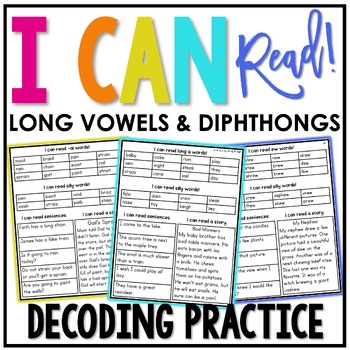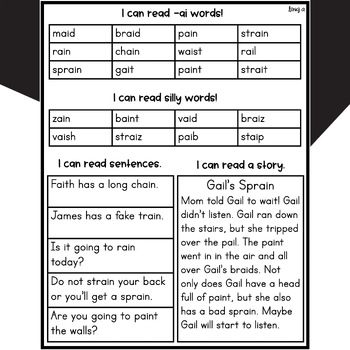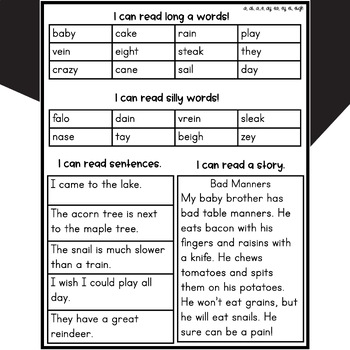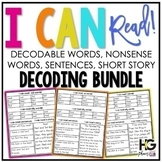Vowel Teams Decoding Drills for Fluency | Real and Nonsense Word Fluency
- PDF
- Easel Activity
What educators are saying
Also included in
- These No Prep I CAN READ phonics based decoding activities are aligned with Science of Reading and perfect for students who are learning to read and write various phonics patterns. Each decodable reader worksheet includes decodable words, nonsense words, sentences, and a short story. These phonics dPrice $37.50Original Price $54.25Save $16.75
Description
These phonics based decoding activities are perfect for students who are learning to read and write long and short vowel combinations, vowel teams, and words with diphthongs. Each decodable sheet includes decodable words, nonsense words, sentences, and a short story. These phonics decodables are designed to move students from slowly blending words to a level where decoding is habitual and automatic.
The Research
I created these decodable sheets to improve fluency. According the the National Reading Panel, a few things are critical of good reading instruction.
•Explicit instruction in phonemic awareness
•Systematic phonics instruction
•Methods to improve fluency
Orton Gillingham states that fluency is built from automatic recognition of a word through repeated encounters. Average students need 4-14 repetitions to achieve automaticity. Struggling readers may need more than 20 repetitions to attain true automaticity.
How can I use these decodable readers in my classroom?
•Use with individual students.
•Learn the pattern in guided reading group. Then, use the sheets as a warmup (the first three-five minutes of group) all week.
•Send home with students as a tool to practice at home.
•Parent volunteers
Each decodable sheet includes:
•12 decodable words
•8 decodable nonsense words
•5 decodable sentences
•A short story
Decodable sheets included:
Long Vowels and Vowel Teams
- -ai says /ā/ (long a) as in strain
- -ay says /ā/ (long a) as in pay
- -eigh says /ā/ (long a) as in eight
- long a mix up (a, ai, a_e, ay, ea, ey, ei, eigh)
- -ee says /ē/ (long e) as in see
- -ie says /ē/ (long e) as in thief
- -ea says /ē/ (long e) as in beach
- -ey says /ē/ (long e) as in key
- -y says /ē/ (long e) as in happy
- long e mix up (ee, e_e, e, ea, ey, y, ie)
- -ie says /ī/ (long i) as in pie
- -y says /ī/ (long i) as in cry
- -igh says /ī/ (long i) as in light
- Long i mix up (i_e, ie, y, igh, i)
- -oa says /ō/ (long o) as in boat
- -oe says /ō/ (long o) as in aloe
- -ow says /ō/ (long o) as in bow
- -old, -ost, -oll as in toll, post, fold
- long o mix up (o_e, oa, oe, ow, o)
- long u /yoo/ (u, ue, ew, u_e) as in music, rescue, few
- long u /yoo/ and /oo/ (oo, u_e, ue, ew, ui, ou, u)
- -ou says /ŭ/ (short u) as in trouble
- -ea says /ĕ/ (short e) as in bread
Diphthongs
- -ui says /oo/ as in fruit
- -ew says /oo/ and /yoo/ as in grew and pew
- -ue says /oo/ and /yoo/ as in glue and cue
- -oo says /oo/ as in food
- -ou says /oo/ and /yoo/ as in soup and coupon
- -oi says /oi/ as in boil
- -oy says /oi/ as in boy
- -ow says /ou/ as in cow
- -ou says /ou/ as in house
- -oo says /oo/ as in foot
- -all as in hall and fall
- -aw says /ô/ as in saw
- -au says /ô/ as in auto
- -a says /ô/ as in wash
- -all, -alk, alt







